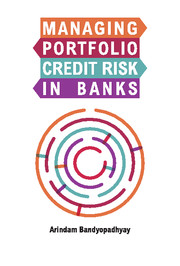Book contents
- Frontmatter
- Dedication
- Contents
- Tables, Figures, Charts
- Preface
- Acknowledgements
- Abbreviations
- 1 Introduction to Credit Risk
- 2 Credit Rating Models
- 3 Approaches for Measuring Probability of Default (PD)
- 4 Exposure at Default (EAD) and Loss Given Default (LGD)
- 5 Validation and Stress Testing of Credit Risk Models
- 6 Portfolio Assessment of Credit Risk: Default Correlation, Asset Correlation and Loss Estimation
- 7 Economic Capital and RAROC
- 8 Basel II IRB Approach of Measuring Credit Risk Regulatory Capital
- Index
5 - Validation and Stress Testing of Credit Risk Models
Published online by Cambridge University Press: 05 May 2016
- Frontmatter
- Dedication
- Contents
- Tables, Figures, Charts
- Preface
- Acknowledgements
- Abbreviations
- 1 Introduction to Credit Risk
- 2 Credit Rating Models
- 3 Approaches for Measuring Probability of Default (PD)
- 4 Exposure at Default (EAD) and Loss Given Default (LGD)
- 5 Validation and Stress Testing of Credit Risk Models
- 6 Portfolio Assessment of Credit Risk: Default Correlation, Asset Correlation and Loss Estimation
- 7 Economic Capital and RAROC
- 8 Basel II IRB Approach of Measuring Credit Risk Regulatory Capital
- Index
Summary
The term “validation” is defined in the minimum requirements of the Internal-rating-based (IRB) approach as follows:
“The institution shall have a regular cycle of model validation that includes monitoring of model performance and stability; review of model relationships; and testing of model outputs against outcomes.” (BCBS, 2004).
The topics of “Model Validation” and “Model Risk Management” have received considerable attention globally in recent years. The US subprime crisis has revealed the necessity of the financial institutions to perform model validation on a regular basis. The Fair, Isaac and Company (now Fair Isaac Corporation or FICO) score was designed to measure risks on credit cards and other short-term consumer credit, but was also used for mortgage lending during good time (Luci Ellis, BIS, 2008). The short-term characteristics of the FICO credit-scoring model developed by the Fair Isaac and Corporation could not predict the actual default risk of subprime mortgage loans in reality. The improper uses of the models and failure to capture important risk drivers in lending products by banks have also been blamed to be responsible for causing the financial crisis in the US. Many researchers and analysts have shown that FICO scores did not indicate any relationship between the borrowers' credit scores and default incidents during the crisis. Wrong application of models, relaxation of lending standards and lack of due diligence in credit led to financial losses and damaged many banks' reputation. These issues have accelerated taking up of model governance initiatives across the banking industry. In this context, Federal Reserve released US SR11-07 guidance on model risk management which provides useful information for banks for adopting a model validation policy. In India, the rising level of non-performing Assets (NPA) and quantum of restructured loans in banks in recent years (especially during 2013–14) are a key concern for the regulator (RBI). This further necessitates checking the predictive power and efficacy of rating models used by banks.
The ability of the bank in managing its credit portfolio depends on the quality of its rating system and its usage for taking conscious credit decisions. The supervisor seeks to encourage banks to develop and use better risk management techniques in monitoring and managing their risks and ensure that they have placed a rigorous process for determining the adequacy of their capital to support all risks to which they are exposed.
- Type
- Chapter
- Information
- Managing Portfolio Credit Risk in Banks , pp. 186 - 234Publisher: Cambridge University PressPrint publication year: 2016

